Lasagna is a classic Italian dish loved for its comforting layers of pasta, savory sauces, cheese, and hearty fillings. However, a common problem many home cooks face is ending up with a runny or watery lasagna. A runny lasagna not only affects the texture but also detracts from the flavors of the dish. Fear not! This guide will walk you through foolproof techniques to create a lasagna that holds together beautifully and is packed with robust flavors. If you’re looking for a creative variation of lasagna, check out this Crock Pot Lasagna Soup Recipe, which transforms the traditional dish into a comforting, hearty soup.
Why Does Lasagna Turn Runny and How to Fix It?
To fix the problem of runny lasagna, we first need to understand what causes it. Here are some of the common culprits:
1. Overly Wet Sauces
One of the biggest mistakes is using a sauce that hasn’t been reduced properly. If your marinara or meat sauce is too watery, it will seep into the pasta layers, making the entire dish soggy.
2. Improper Layering
Layering is an art. Too much sauce or cheese in one layer can overwhelm the structure and create excess liquid.
3. Uncooked or Overcooked Noodles
When noodles aren’t cooked to the right texture or when you use them straight from the box without enough preparation, they can release extra moisture into the dish as it bakes.
4. Watery Ricotta or Vegetables
Ricotta cheese, spinach, and other vegetables often release water during cooking. This can lead to a watery final product if not addressed beforehand.
Ingredients for a Perfect, Non-Watery Lasagna
Choosing the right ingredients is essential for creating a lasagna that isn’t runny. Here’s what to consider:
1. Pasta
Use quality lasagna sheets that cook evenly and don’t tear easily. Pre-cooked or no-boil sheets can also help control the moisture content.
2. Sauces
Choose a thick, hearty meat or marinara sauce. If making the sauce from scratch, simmer it long enough to evaporate excess liquid.
3. Cheese
Ricotta, mozzarella, and Parmesan are staples, but choosing the right texture matters. Avoid ricotta with a high moisture content; instead, opt for full-fat, high-quality cheese.
4. Vegetables
If you’re adding spinach, mushrooms, or zucchini, pre-cook them to remove excess water. Sautéing or roasting works well for this purpose.
Step-by-Step Guide: How to Make Lasagna Without Being Runny
1. Dry Your Ingredients
- Ensure your ricotta is drained using a cheesecloth or a fine-mesh sieve.
- Pat dry vegetables like zucchini or mushrooms after cooking them.
2. Thicken Your Sauce
Simmer your sauce until it clings to the back of a spoon. If you’re short on time, use a small amount of cornstarch or flour to thicken it.
3. Prepare the Noodles Properly
- Parboil lasagna noodles until slightly undercooked, as they will finish cooking in the oven.
- If using no-boil noodles, ensure your sauce is slightly wetter but not runny to compensate.
4. Layer Strategically
Start with a thin layer of sauce at the bottom of the dish. Add pasta, followed by a mixture of cheese, sauce, and meat or vegetables. Alternate wet and dry layers to balance moisture.
The Role of Sauce Consistency in Non-Runny Lasagna
The consistency of your sauce can make or break your lasagna. A watery sauce can seep into the layers, ruining the texture, while a too-thick sauce might lead to dryness. Here’s how to get it just right:

1. Reduce Your Sauce
Simmer your sauce for 20–30 minutes to evaporate excess water. This step is essential for both marinara and meat sauces. For added flavor, let the sauce cook with onions, garlic, and herbs before reducing.
2. Thicken with Ingredients
- Tomato Paste: Add a spoonful to give the sauce a richer consistency.
- Breadcrumbs or Flour: Stir in small amounts to absorb excess liquid.
3. Avoid Water-Laden Additions
If you’re using canned tomatoes, drain some of the liquid before adding them to your sauce. Similarly, avoid adding water unless absolutely necessary.
Pasta Preparation Tips for a Firm Lasagna
1. Parboiling the Noodles
- Cook your noodles until they are slightly underdone (al dente). They will absorb moisture from the sauce while baking, ensuring they don’t become overcooked.
- Add a dash of olive oil to the boiling water to prevent sticking.
2. Using No-Boil Lasagna Sheets
No-boil noodles are a convenient option but require careful sauce preparation. The sauce should be slightly thinner than usual to hydrate the pasta as it cooks.
Layering Techniques for a Firm Lasagna

1. The Right Base Layer
Always start with a thin layer of sauce at the bottom of your baking dish. This prevents the noodles from sticking and ensures even cooking.
2. Alternate Wet and Dry Layers
- After the base, add a layer of pasta, then a layer of cheese and sauce.
- Avoid piling too much wet ingredient in a single layer. Instead, spread them thinly to maintain balance.
3. Cheese as a Stabilizer
Distribute cheese evenly to help bind the layers. A light sprinkle of Parmesan on top of each layer adds extra flavor and stability.
The Best Cheese Choices for Non-Watery Lasagna
Cheese is a star ingredient in lasagna, but the type and application make a significant difference:
1. Ricotta Cheese
- Use ricotta that’s been drained to remove excess moisture.
- Mix it with egg and herbs for a creamy, thick consistency that holds its shape during baking.
2. Mozzarella Cheese
- Use full-fat mozzarella for the best flavor.
- Shred it yourself instead of using pre-shredded cheese, which often contains anti-caking agents that affect melting.
3. Parmesan Cheese
This aged cheese adds a sharp, salty flavor and helps with browning. Sprinkle it generously on the top layer for a golden crust.
Why Resting Is Key to Firm Lasagna
One of the most overlooked steps in making lasagna is letting it rest after it comes out of the oven.
1. Why Resting is Important
- It allows the layers to set, preventing the dish from falling apart when sliced.
- Excess moisture gets reabsorbed during this resting period, creating a firm, sliceable texture.
2. How Long to Rest
- Let the lasagna sit for at least 20–30 minutes before serving. Cover it loosely with foil to retain warmth.
Avoid These Mistakes to Make Lasagna Without Being Runny
Even the most seasoned cooks can make errors when preparing lasagna. Here are some common pitfalls and how to sidestep them:
1. Using Too Much Sauce
While sauce is crucial, overloading layers with it can lead to sogginess. Aim for thin, even layers of sauce to maintain balance.
2. Skipping Pre-Cooking for Vegetables
Raw vegetables release water as they cook, creating excess liquid. Always sauté or roast vegetables like zucchini, mushrooms, or spinach before layering them into your lasagna.
3. Not Draining Ricotta
Ricotta can be surprisingly watery. Skipping the step of draining it leads to runny layers. Use a cheesecloth or fine sieve to remove the moisture.
4. Forgetting to Rest the Lasagna
Cutting into the lasagna immediately after it’s out of the oven causes it to fall apart. Letting it rest ensures a firm texture.
How to Use Thickening Agents for Perfect Lasagna Layers
Thickening agents are lifesavers when it comes to controlling moisture. Here are some options:
1. Breadcrumbs
Sprinkle a light layer of breadcrumbs between layers to absorb any excess moisture without altering the flavor.
2. Cornstarch or Flour
Mix a small amount of cornstarch or flour into the ricotta or sauce to help bind the ingredients and reduce liquid.
3. Cheese Blends
Using firmer cheeses like Parmesan in combination with softer cheeses can add texture and prevent watery layers.
Beginner Tips to Make Lasagna Without Being Runny
If you’re new to lasagna-making, these tips will help you avoid a runny mess:
1. Test Sauce Consistency Before Layering
Dip a spoon into your sauce—if it clings lightly without running off, it’s ready.
2. Use a Deep Dish
A deep baking dish helps prevent overflow and ensures even cooking.
3. Cover with Foil While Baking
Cover the dish with foil for the first half of the baking time to retain moisture, then uncover it to achieve a golden-brown crust.
4. Cook in Advance
Lasagna often tastes better the next day, as the flavors meld together, and the structure becomes firmer.
FAQs: How to Make Lasagna Without Being Runny
1. Why is my lasagna watery even after following the recipe?
Watery lasagna is often caused by excess moisture in the sauce, ricotta, or vegetables. Ensure all ingredients are properly prepared and drained.
2. Can I use no-boil noodles without making the lasagna runny?
Yes, but you need to ensure your sauce is slightly wetter than usual, as no-boil noodles absorb more liquid during cooking.
3. How do I thicken ricotta cheese?
Mix ricotta with an egg and some grated Parmesan. You can also strain it using cheesecloth to remove excess moisture.
4. How long should I bake lasagna?
Bake lasagna at 375°F (190°C) for 40–50 minutes. Cover it with foil for the first 30 minutes, then remove the foil for the remainder to achieve a golden crust.
5. Can I freeze lasagna to avoid runniness?
Yes, freezing lasagna before or after baking can help firm up the layers. Just be sure to thaw it thoroughly before reheating.
6. Is it okay to add raw vegetables to lasagna?
Adding raw vegetables can lead to excess water in the dish. Always sauté or roast vegetables beforehand to prevent this.
Conclusion: How to Make Lasagna Without Being Runny
Making lasagna without being runny is all about preparation, balance, and patience. By thickening your sauces, draining your ricotta, pre-cooking your vegetables, and layering strategically, you can create a lasagna that holds its shape beautifully and is bursting with flavor. Don’t forget to let it rest before serving—this final step ensures that your lasagna will look as good as it tastes. Happy cooking!

